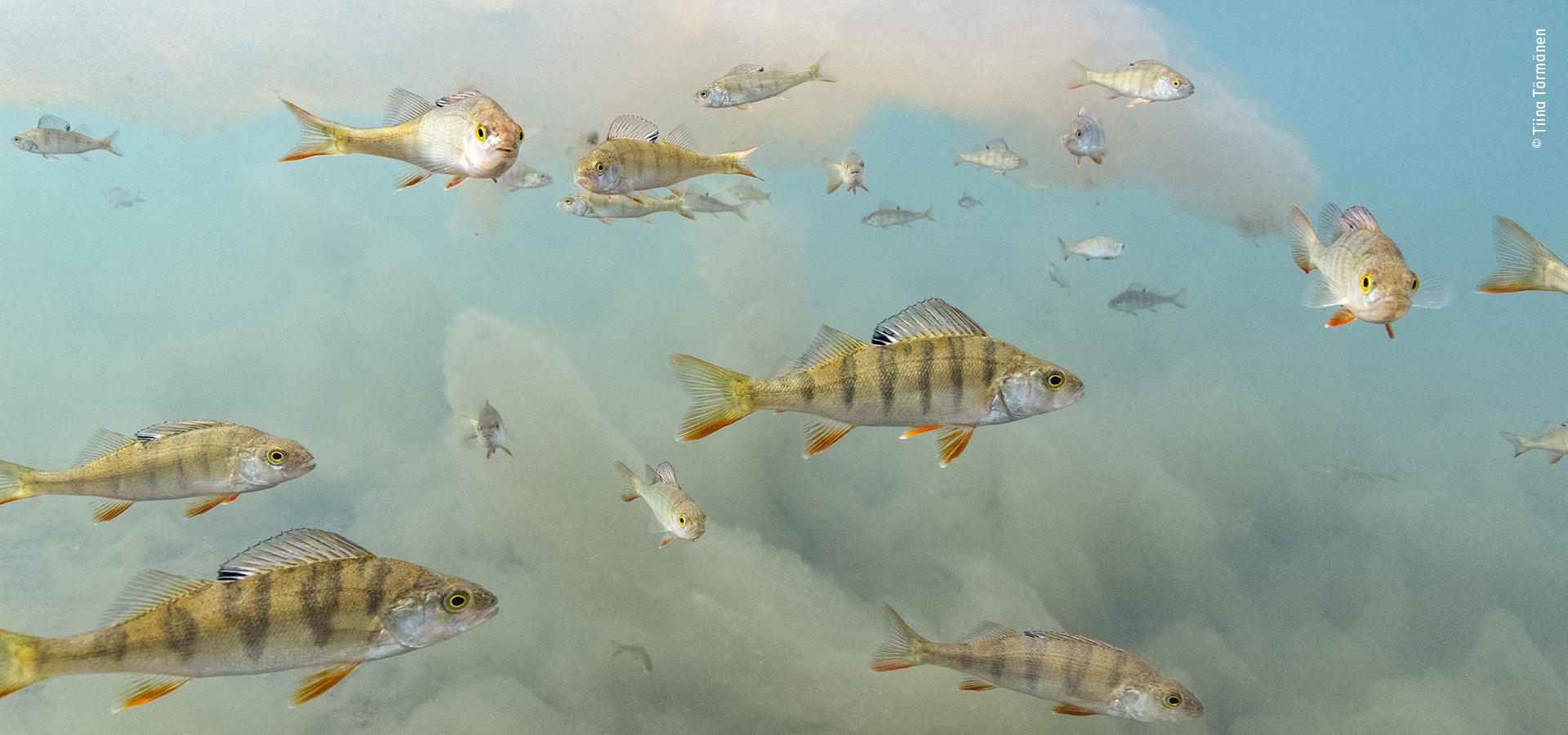
A school of European perch seem to be floating in the clouds in this surreal scene. In reality the clouds are algal blooms, a common result of pollution.
Underwater wonderland © Tiina Törmänen.
First Look at Wildlife Photographer of the Year 58
Alison Groom
First published 1 September 2022
As Wildlife Photographer of the Year moves into its fifty-eighth year, join us with a sneak peek exploring some of the amazing animal behaviours, awe-inspiring landscapes and powerful photojournalism stories that make up the new exhibition.
Book your tickets now.
The lost floods by Jasper Doest
Lubinda Lubinda, station manager for the Zambezi River Authority, stands in front of his old house (left) and new house (right). Frequent droughts along the Zambezi River have meant that when he needed to build a new house, it didn't need to be built as high.
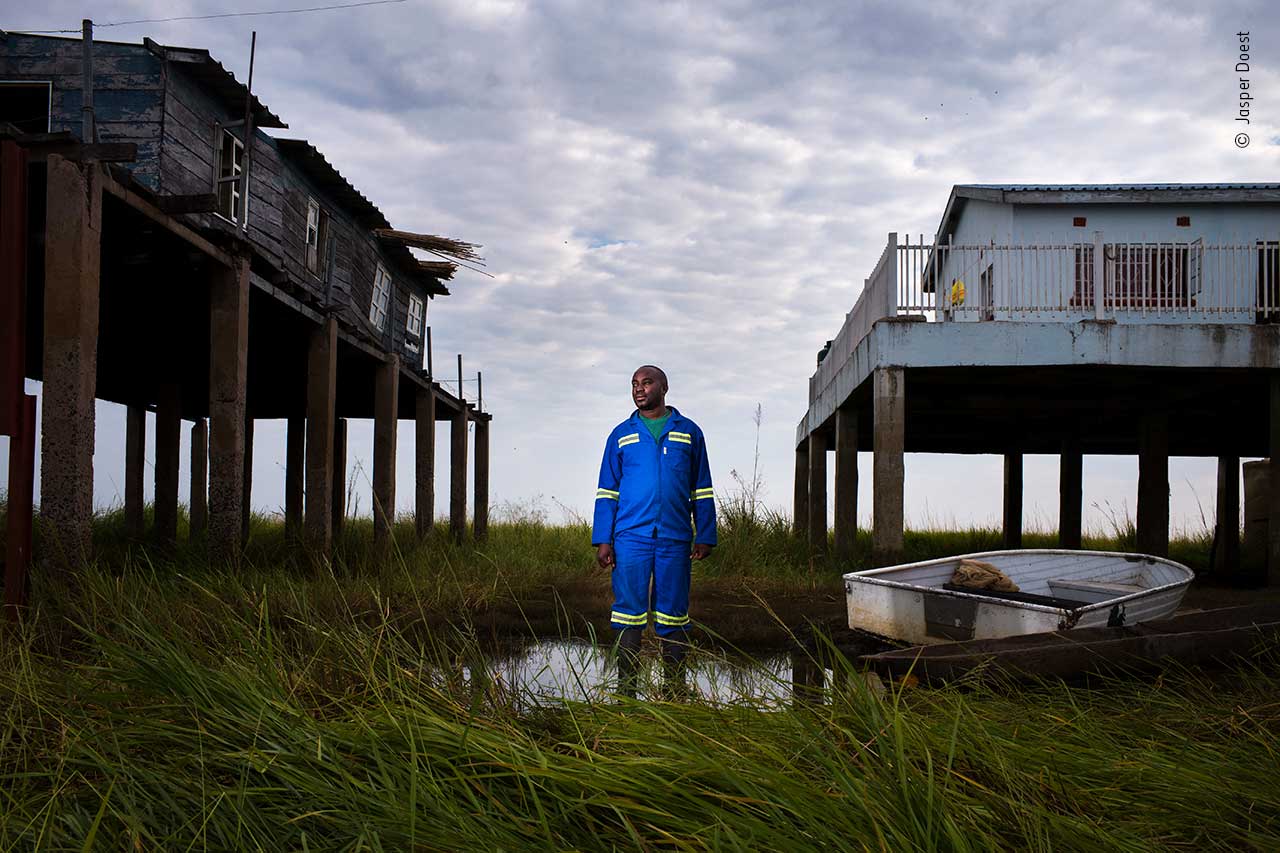
The lost floods © Jasper Doest
Deforestation along the river paired with the warming effects of climate change have resulted in reduced rainfall in the region, depleting soil fertility and altering the area's fragile ecology.
The wetland provides people with fish, pasture for livestock, fertile soil, and vegetation for thatching and making household items. In other regions, rising sea levels and extreme rainfall events are causing flooding.
The octopus case by Samuel Sloss
Samuel was muck diving, which involves slowly moving along the volcanic sands of Lembeh Strait, Indonesia, to spot wildlife when he noticed this octopus hiding in a shell.
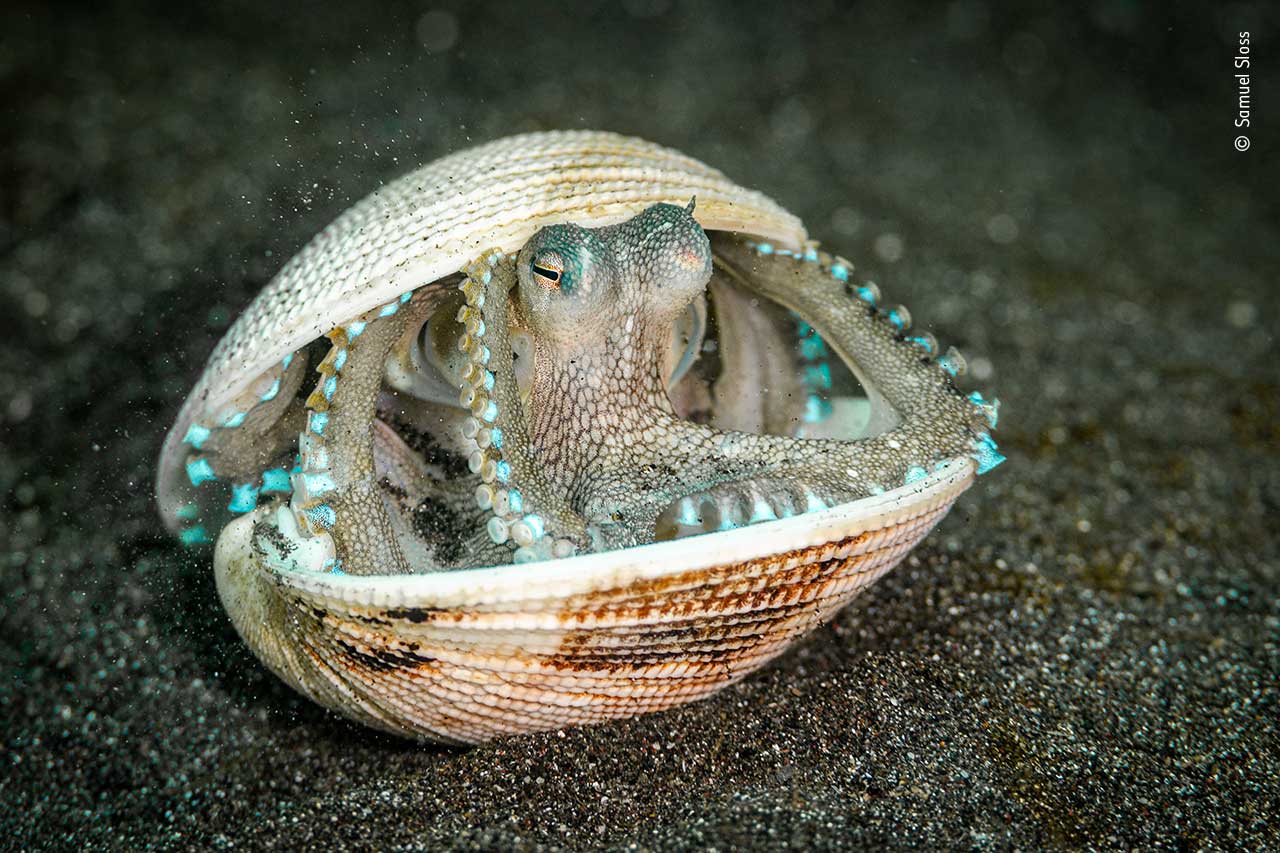
The octopus case © Samuel Sloss
Being careful not to distress it while getting this striking shot, Samuel waited for the octopus to open the shell, revealing its colourful body inside.
To protect its soft body when foraging on sand or mud, the octopus finds, cleans and carries shells or other suitably sized objects to hide in. This behaviour demonstrates their capacity to anticipate and plan as well as the intelligence and dexterity to assemble the half shells – effectively using them as tools.
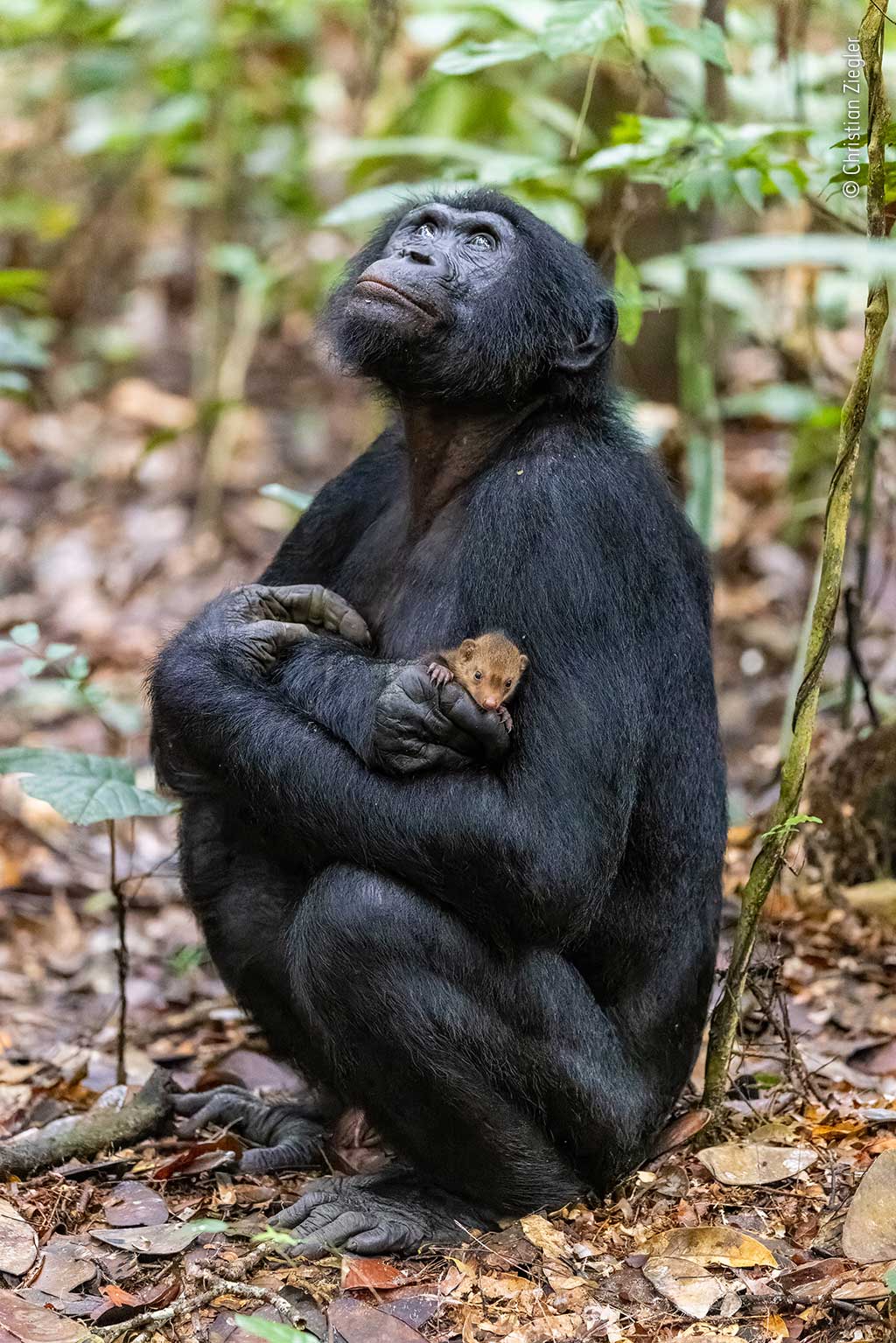
The bonobo and the mongoose © Christian Ziegler
The bonobo and the mongoose by Christian Ziegler
Christian had tracked a group of bonobos through a flooded forest when he spotted this young male bonobo gently holding a mongoose pup.
'The bonobo held and stroked the little mongoose for more than an hour,' says Christian, 'carrying the pup carefully as it climbed a tree to eat fruit.'
Bonobos are mainly herbivorous but occasionally they hunt. The mongoose pup – eventually released unharmed – may have been taken when its mother was killed.
Just one day's catch by Srikanth Mannepuri
Srikanth used a drone get a bird's-eye view of a market to demonstrate the scale of the day's marlin and sailfish catch.
The local fishermen use traditional longline techniques and sail-powered boats to reach deep water in the Bay of Bengal, where Sailfish and marlin are found. However, the size of the catch is unregulated, and with so many immature fish caught, the industry is unsustainable.
Globally, 85% of fish stocks are currently overexploited by humans.
Without urgent efforts to protect marine habitats and create truly sustainable fishing practices, we will soon begin to lose species forever.
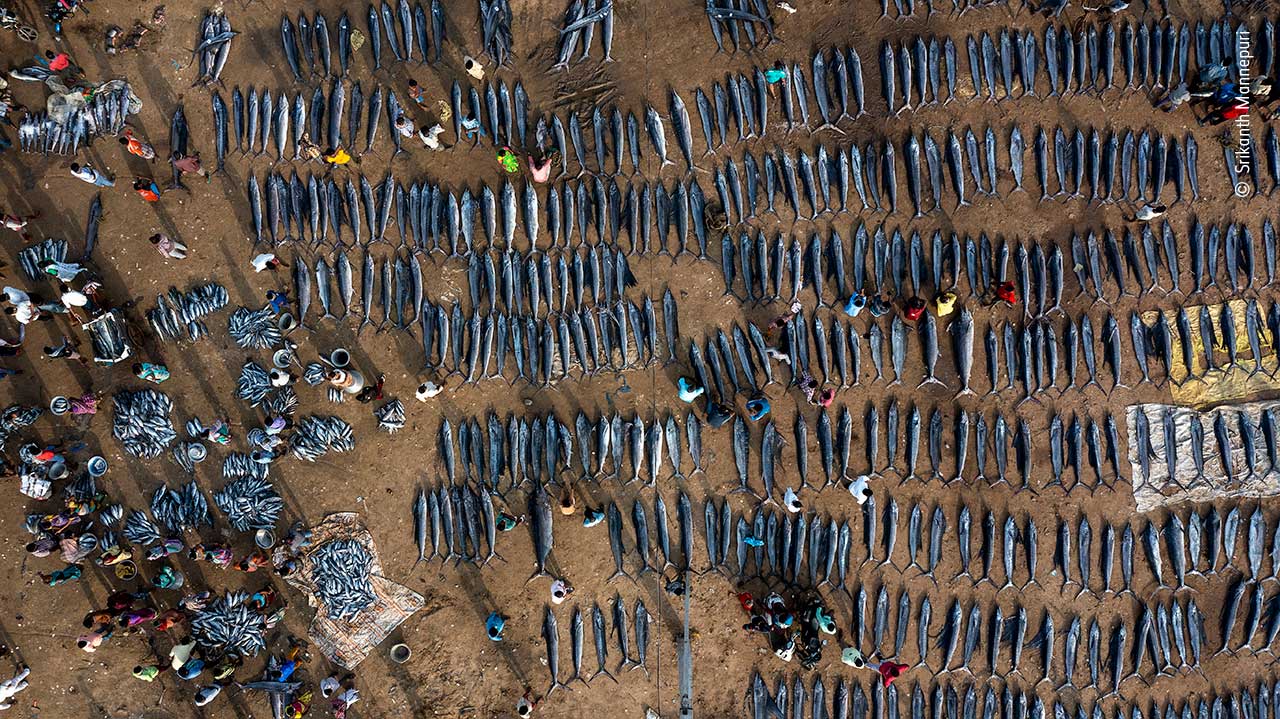
Just one day's catch © Srikanth Mannepuri
The right look by Richard Robinson
Richard spent 30 minutes with this young southern right whale as it curiously inspected him: circling him, swimming off and then returning for another look.
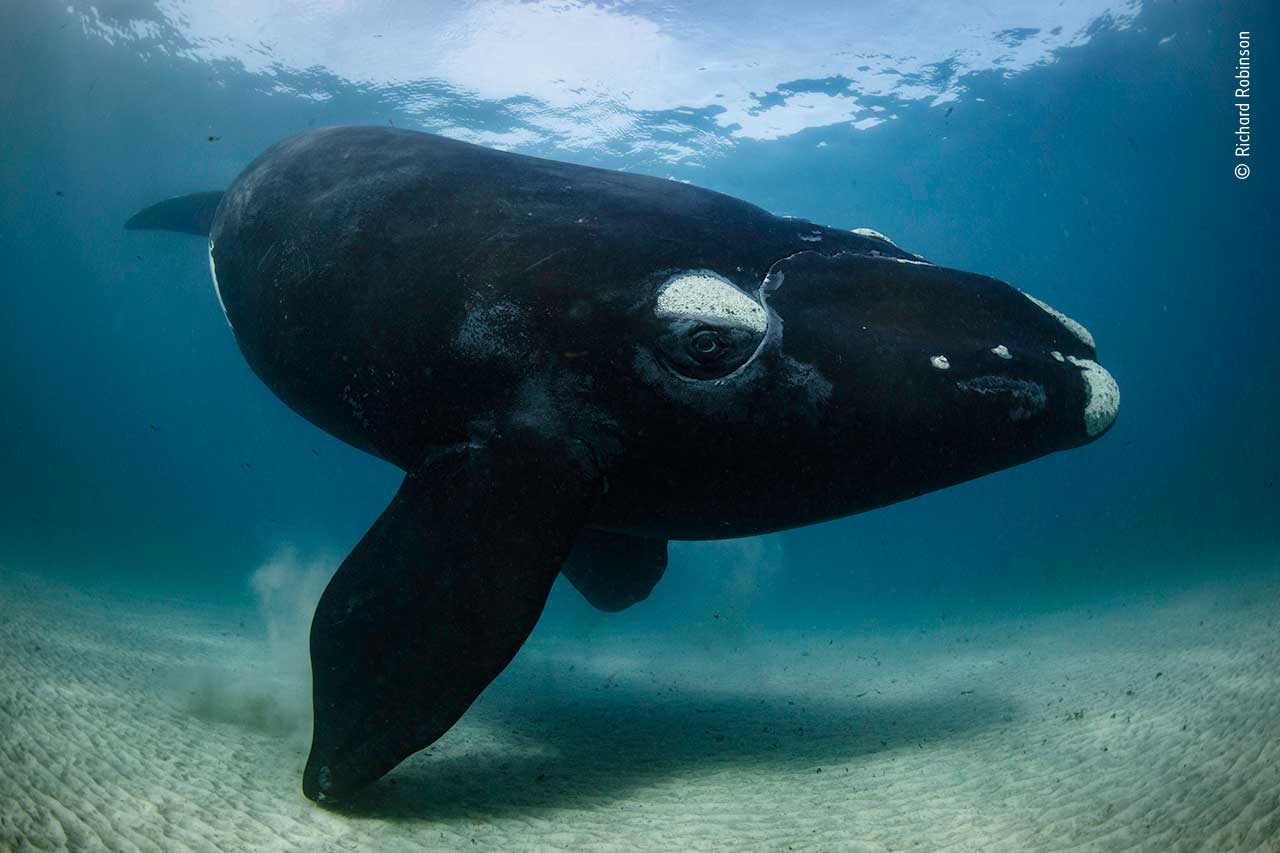
The right look © Richard Robinson
Shot under New Zealand Department of Conservation permit #84845-MAR
Richard's main challenge was to keep far enough from the curious calf to photograph it.
New Zealand's population of southern right whales, known as 'tohorā' in Māori, were hunted to near extinction first by European whalers in the 1800s, and then by Soviet whalers in the 1900s. Now protected, the population has bounced back from a small group with just 13 breeding females, to more than 2,000 individuals.
Wanted! by Britta Jaschinski
Britta photographed a piece of coltan, glowing blue in torchlight, surrounded by mining tools, gorilla bones and porcupine quills, which were seized by customs authorities.
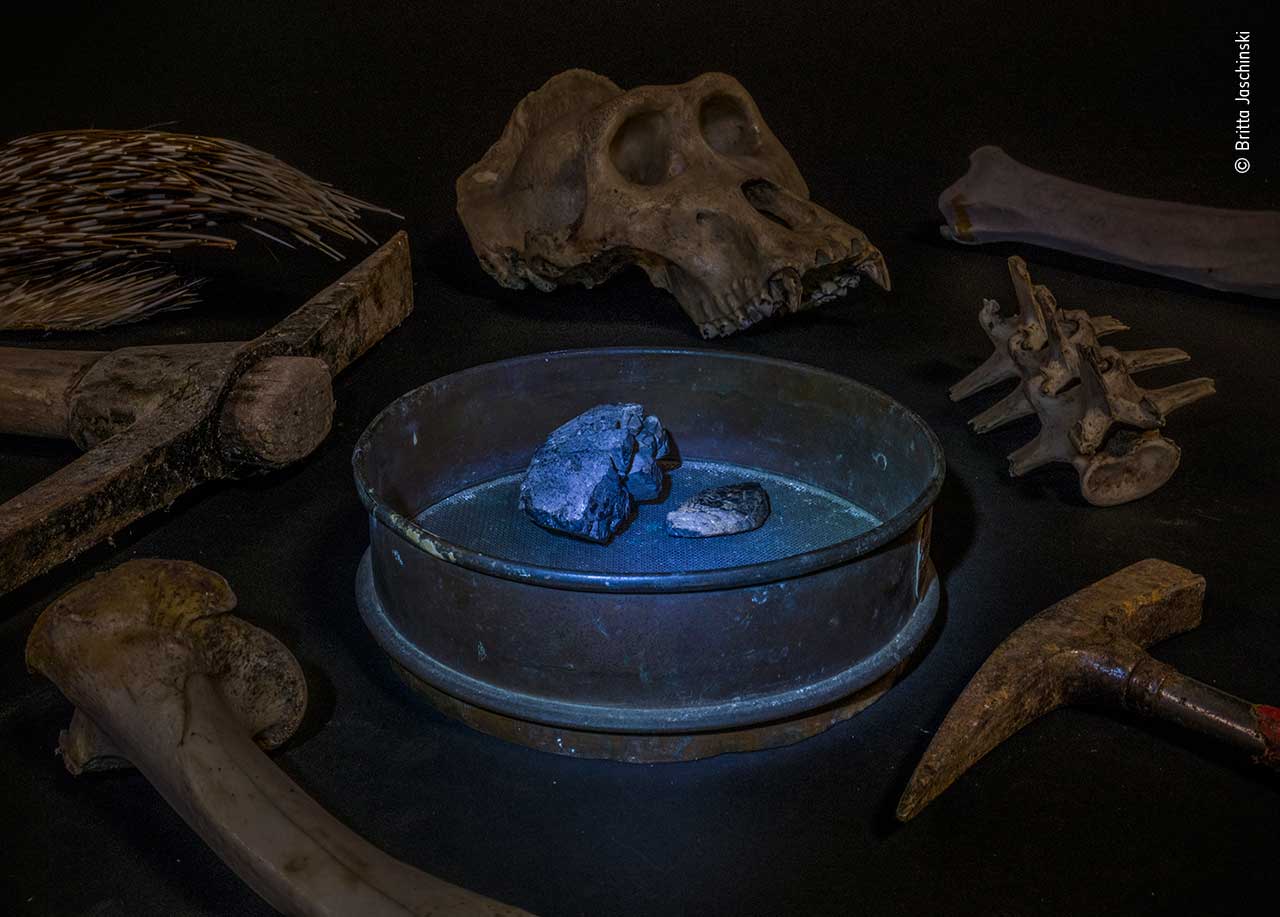
Wanted! © Britta Jaschinski
Coltan is an important component in mobile phone and laptop batteries that is extracted from riverbeds in the Democratic Republic of the Congo.
Britta's composition draws attention to the wildlife casualties of the industry and the poorly paid miners who hunt wild animals for food. The hunting and trading of wildlife threatens the future of the country's gorillas and has led to an increased risk of viruses jumping to humans.
The disappearing giraffe by Jose Fragozo
Jose kept his camera steady in the moving vehicle, as he watched a giraffe disappear among the tall pillars of Kenya's new Mombasa-Nairobi Standard Gauge Railway.
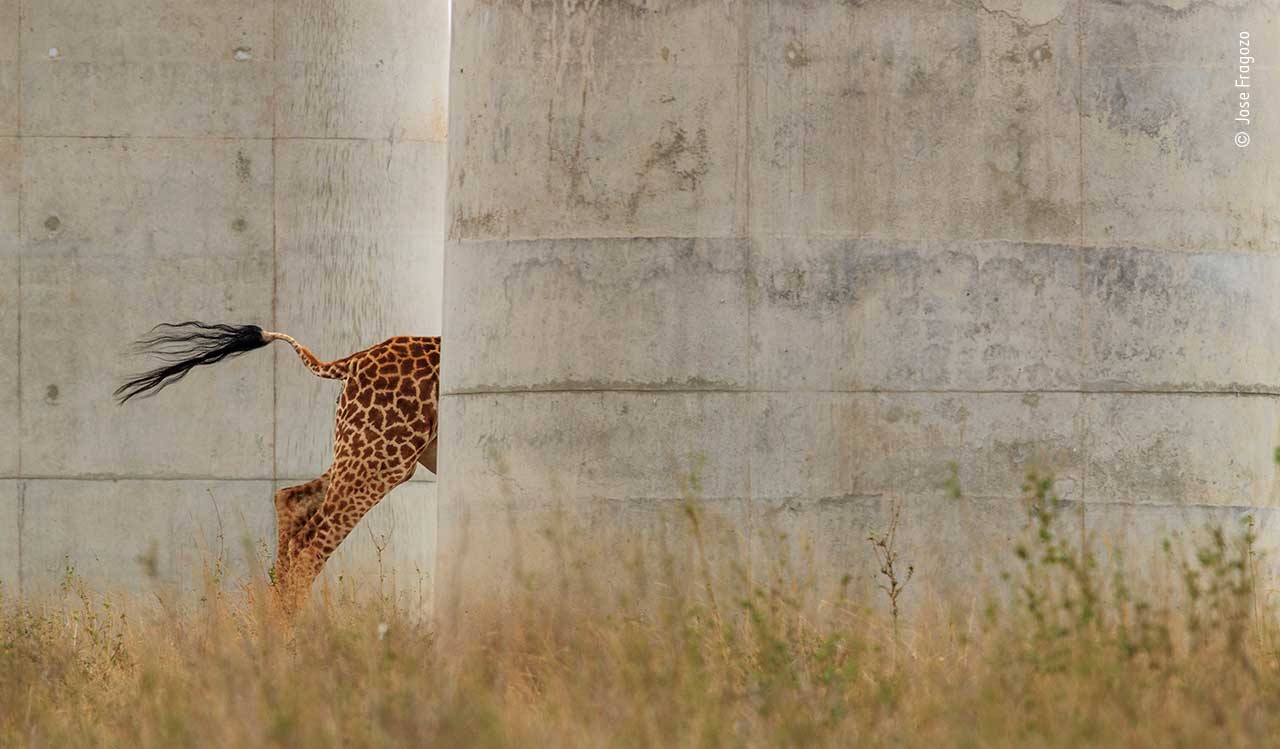
The disappearing giraffe © Jose Fragozo
Though this stretch of railway running through Nairobi National Park is raised on giant columns, allowing animals to move under it, this picture is symbolic of how the space for wildlife continues to be squeezed.
Each individual Maasai giraffe has unique markings, but elements of their pattern may be passed down from mother to offspring. Their numbers have declined from a historic estimate of more than 63,000 individuals to 35,000 and still decreasing.
Around the world, human development continues to encroach on the range and habitats of animals.
Treefrog pool party by Brandon Güell
Brandon endured mosquitoes and chest-deep water in order to document this rare breeding frenzy of gliding treefrogs.
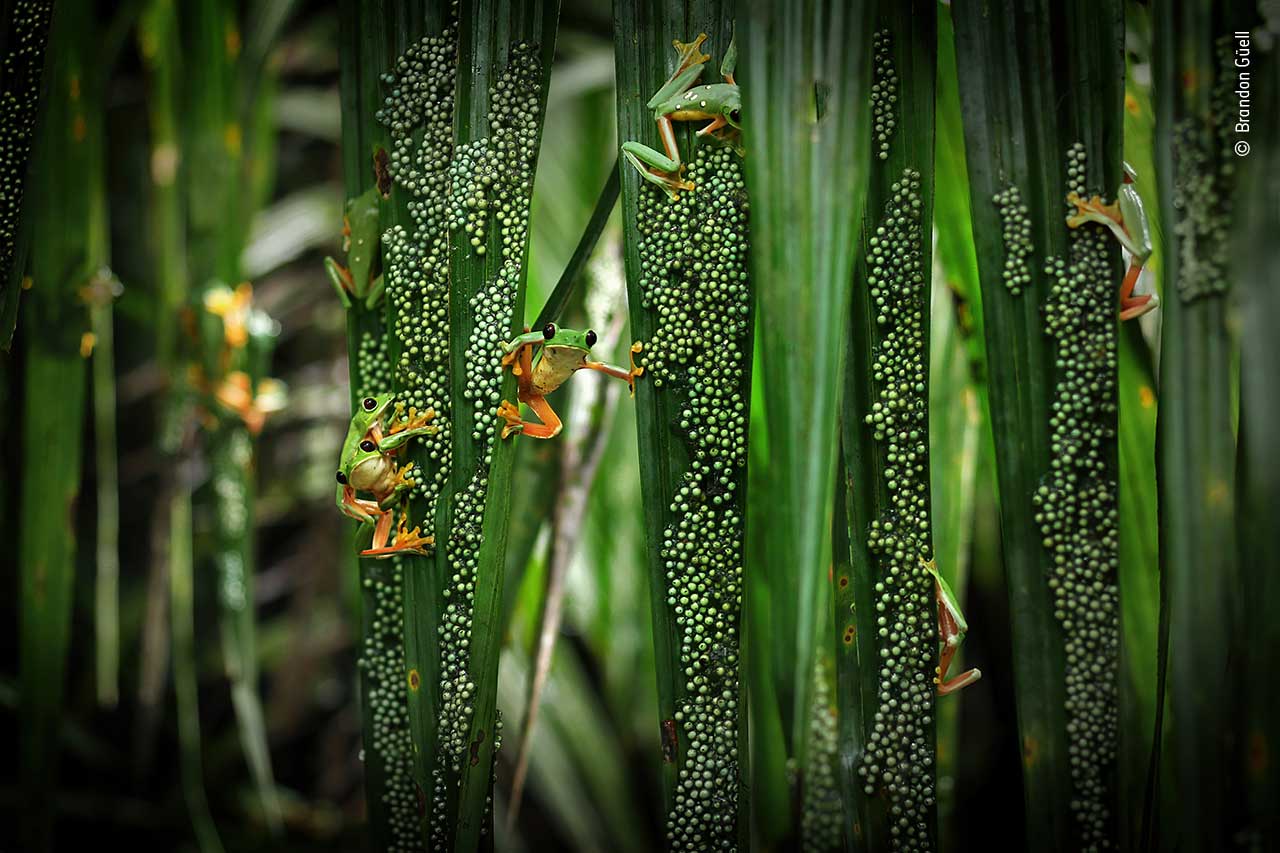
Treefrog pool party © Brandon Güell
These spectacular mass-breeding events occur in only a few remote locations in Central and South America, a few times a year making them hard to predict. Brandon had been getting up at 4am for days in a row in anticipation of finding one.
At dawn, after torrential rain, thousands of female gliding treefrogs arrive at the specific pools to lay their eggs on overhanging palm fronds. Once laid, the male frogs move in to fertilize the eggs which are green at first, but soon reveal the developing embryos inside.
Sloth dilemma by Suzi Eszterhas
The brown-throated sloth had already made it across a road, but to reach the next clump of trees it needed to return to the ground and crawl. That was when it met the big dog.
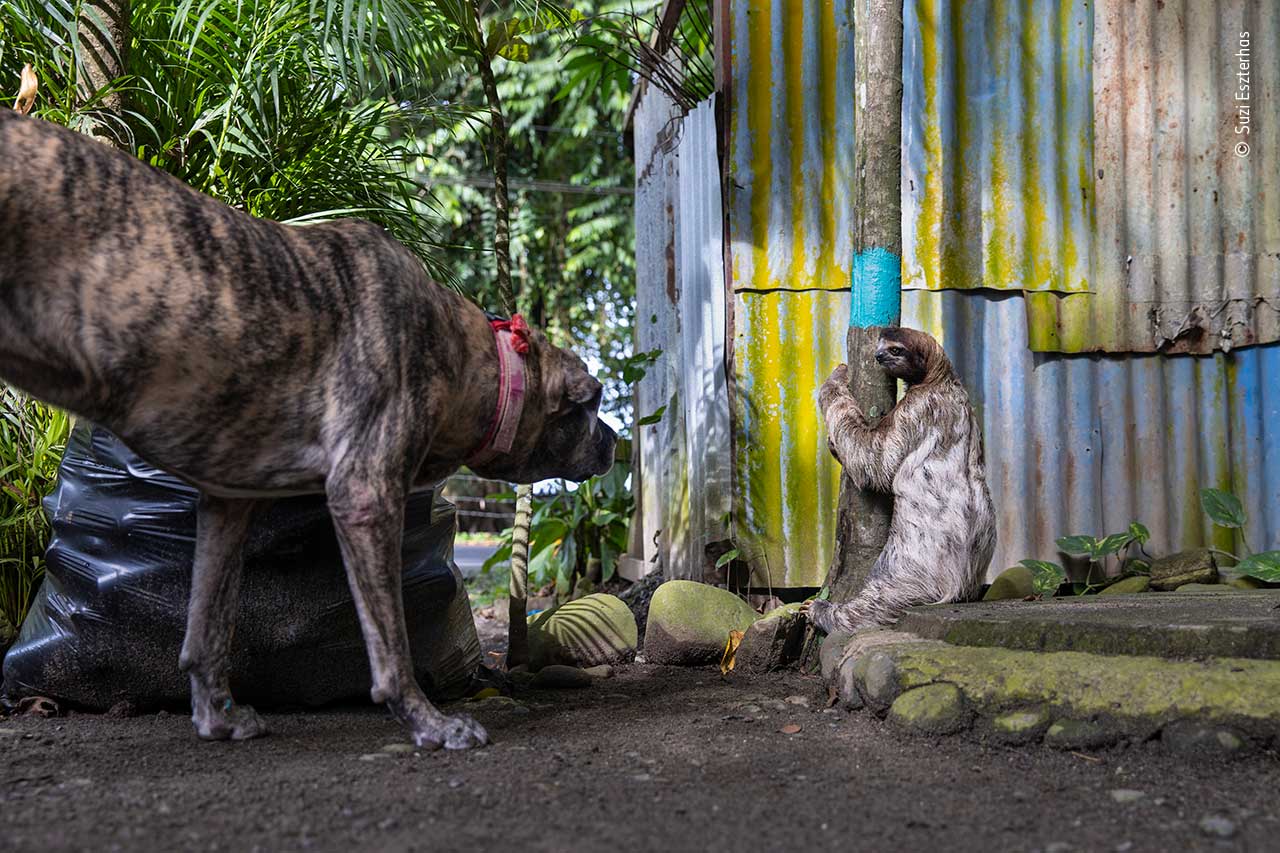
Sloth dilemma © Suzi Eszterhas
When this sloth sensed danger, it froze. Fortunately, this particular dog, 'had recently taken part in a training programme run by the Sloth Conservation Foundation,' Suzi explains. 'So when the owners called it off, the dog obeyed.'
In the rainforest, sloths only descend to the ground about once every five days to defecate. But with increasing habitat loss and the fragmentation of the nearby forest, they are increasingly forced on vulnerable journeys across urbanised areas to find food, suitable habitats and mates.
Polar frame by Dmitry Kokh
When Dmitry's boat approached the small island of Kolyuchin, an uninhabited island in the remote Russian Far East, he did not expect to see a figure at the window of an abandoned house.
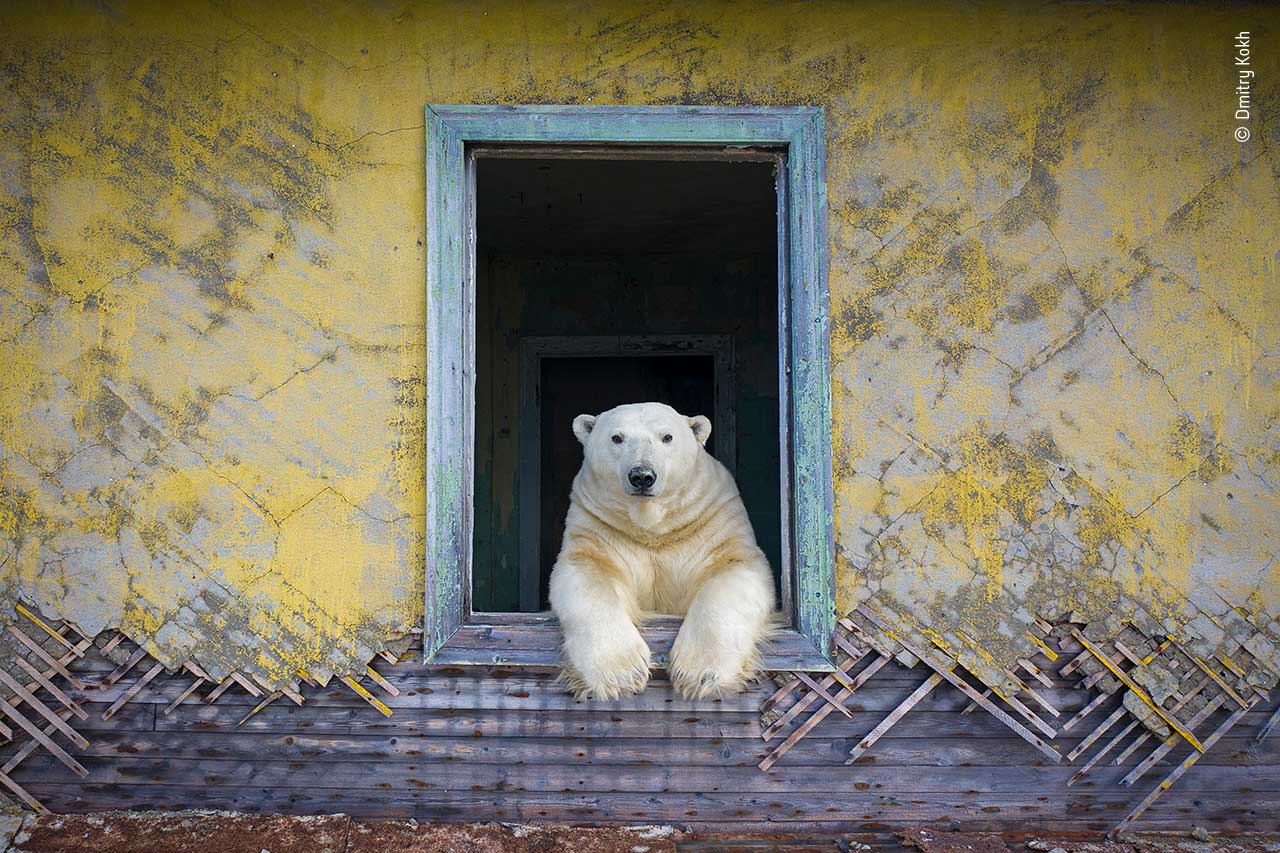
Polar frame © Dmitry Kokh
Binoculars revealed that over 20 polar bears were exploring the ghost town, which has been abandoned since 1992. It was too dangerous to land on the island, so Dmitry used a low-noise drone to document the surreal experience.
With climate change reducing sea ice, hunting is becoming increasingly difficult for the bears, pushing them closer to human settlements to scavenge for food.
Don't miss a thing
Receive email updates about our news, science, exhibitions, events, products, services and fundraising activities. We may occasionally include third-party content from our corporate partners and other museums. We will not share your personal details with these third parties. You must be over the age of 13. Privacy notice.
Follow us on social media